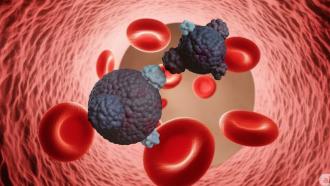
53-year-old Sheila (name changed) noticed abdominal pain as she woke up one morning. With her daughter’s marriage due in a month and preparations underway, Sheila dismissed it. After the wedding, when the guests had departed, the frequency of her pains increased, and she visited her gynaecologist. The gynaecologist performed an internal ultrasound examination to check her vagina, cervix, uterus and ovaries, and referred her to an oncologist. Sheila knew that very little good news awaited her. She had stage 3 ovarian cancer.
Sheila’s experience is far too common in patients with ovarian cancer. Incidence of ovarian cancer ranges from 1.7–15.2 per 10,000 women in India and is the second-highest in the world. Ranga Kumar, a counsellor for families battling cancer in Chennai, says, “Most cases that I come across are women in their late 40–50s. Often, they have already given up as there are few remedies available at this late stage.”
Ovarian cancer often goes undetected until it spreads to the pelvis and abdomen. When detected early, ovarian cancer can be treated by surgically removing the malignant tumour before it spreads to other parts of the body. Along with chemotherapy, this approach provides a better quality of life and more prolonged survival for the patient.
Current screening methods are physical examination, an internal ultrasound scan of the uterine region and a blood test for cancer antigen (CA-125). Cancer detection during a physical examination is dependent on the examiner’s expertise and can misdiagnose other conditions as ovarian cancer. Ultrasound scans reveal tumours but can’t tell whether they are benign or cancerous. The CA-125 antigen is a good test for cancer surveillance but not for early detection. High CA-125 levels can also be due to endometriosis or inflammation. Even when put together, these methods cannot detect ovarian cancer in early stages.
“While the cure rate for early ovarian cancer (stages 1&2) is 90%, the same is a dismal 5–10% for anything beyond stage 2. Hence, it is vital to diagnose ovarian cancer at an early stage,” says Dr D Raghunadharao, former Director at the Tata Cancer Centre, Visakhapatnam.
In a recent study, Prof Thangarajan Rajkumar and his team at Cancer Institute, Chennai have identified five proteins that can be tested in the blood to facilitate reliable and early detection of ovarian cancer. When it goes to market, the test could cost as much as a Computerized Tomography or CT Scan. Being a simple test, a patient need not visit the hospital to get it done. Routine blood sampling could be done in the comfort of their home, and the test can be run in a regular pathological laboratory, akin to testing for thyroid levels or liver functions. The study, supported by the Department of Science and Technology, Government of India, was published in the Journal of Proteomics.
The researchers began their work with plasma samples of ovarian cancer patients and screened over 3,149 proteins using high-resolution mass spectrometry. In this method, proteins are first converted into vapour in a sealed chamber, and an electric field is applied across to charge them. Depending on their own charge, the vaporised proteins start moving towards their opposite charge. The lightest weighing ions move fastest and are detected first by the detector. After the sample is analysed, a map of all proteins is made based on their size and charge. It helps in the rapid identification of proteins and their relative levels in the sample.
As a next step, the researchers compared the protein levels in cancerous blood samples to healthy samples that were unaffected by cancer. They found that levels of 455 proteins had almost doubled, whereas 52 proteins had halved in patients with ovarian cancer. Some of these 52 proteins had been associated with ovarian cancer by other studies, providing validation for their work. But, mass spectrometry requires specialised equipment and trained technicians to run samples regularly. The researchers needed a simpler way to detect these proteins.
Enzyme-Linked Immunosorbent Assay or ELISA is a cheaper testing alternative. This method captures the protein of interest using specific antibodies on a small plastic plate with many wells. Each well analyses one sample. Available in 96-well and 384-well formats, ELISA leverages the economy of scale to make testing cheaper.
In this method, a protein-specific antibody is first fixed on the plate. The sample is then introduced into the well, where the fixed antibody locks onto the protein. A second protein-specific antibody is then introduced. This also binds to the protein of interest, making a protein-sandwich, with the two antibodies on either side. The second antibody carries an enzyme that acts on a substrate and changes its colour. Greater the protein level in the sample, greater is the secondary antibody bound to it and faster, the colour change of the substrate.
However, using over 500 proteins to diagnose a disease is cumbersome. The researchers needed to arrive at a smaller set of proteins to make an accurate diagnosis. Using a combination of the function of the protein and where it is found in the cell, the researchers narrowed down to 25 proteins. To rapidly screen these proteins, they used a Quantibody array. This method performs many ELISA assays in parallel to save time and effort. Instead of using wells, this array performs ELISA on a glass slide.
On a custom-built Quantibody array, the researchers analysed 21 of these proteins on 96 known ovarian cancer patient samples and 218 healthy controls. Median values of six of the proteins were significantly higher in tumour samples than in the control sample. These results were like the results obtained earlier using mass-spectrometry, validating their findings. But, to make a diagnostic tool, the team needed to come up with something even simpler.
This is where statistics came to their rescue.
“We used a method called Discriminant Analysis, which helps in distinguishing if a protein is differentially expressed. This helps us distinguish a normal sample from a cancer patient sample,” explains Rajkumar.
In this method, the researchers used the results for all 21 proteins used in the Quantibody array. When a test detects a positive sample accurately, the detection is a true positive. On the other hand, when it detects a normal sample inaccurately, the detection is a false positive. By plotting the true-positive rate and false-positive rates, the researchers determined which protein combinations detected positive samples reliably. The proteins which performed well were then taken up for final ELISA validation.
Nine proteins were then included in the final analysis to test 118 samples of various ovarian tumours, 20 benign tumours and 238 control samples. All samples were tested using individual ELISA assays for each protein. CA125, IGFBP2 and SPP1 levels were significantly higher in tumour samples than in control and benign tumour samples. Adipsin and TSP1 levels were markedly lower in the tumour samples than in control and benign tumour samples. 78 normal samples and 82 ovarian cancer samples were used to perform multivariate (multiple proteins) analysis and discriminate between healthy and ovarian cancer samples. The test detected tumour samples with 94.87% specificity and 90.24% sensitivity.
“Currently, the ELISA can be done using the kits available in any good laboratory. The ELISA assays are available for research use except for CA125, which is for clinical diagnostic use,” says Rajkumar.
However, a limitation of the study is that only 5% of the cancer samples were in stage 1 and fewer were of borderline ovarian cancers. Hence, further validations are needed for reliable detection of early-stage ovarian cancer.
Genetic screening is now able to tell who is at a greater risk of developing ovarian cancer. Women at high-risk can opt to get their ovaries removed through a process called prophylactic oophorectomy, which reduces their chances by up to 80%. “Oophorectomy deprives women of hormonal secretions with loss of libido and reproductive ability. These hormonal secretions have protective functions for the heart and bones too,” shares Raghunadharao. The current test can be used to monitor women at high risk as it can pick up the disease early and help plan interventions, if necessary.
As a next step, the researchers are hoping to turn their innovation into a marketed product. “The Biotechnology Industry Research Assistance Council (BIRAC) will be willing to consider funding support for this,” shares Rajkumar. BIRAC is a public sector enterprise set up by the Government of India to bridge gaps between academia and industry and facilitate the development of affordable, high-quality products. They have filed a patent for their method of detecting ovarian cancer, which they hope will help them secure incubation funds and also help Cancer Institute earn some royalty.
The researchers are looking to tie up with an industry partner who can develop multiplexed assays like the Quantibody array. After finding one, they would validate their testing procedure in the real world with healthy women, patients with benign diseases of the ovary and those with ovarian cancer.
Research into early detection is the need of the hour for ovarian cancer patients. From her experience of counselling patients for over 30 years, Ranga Kumar says, “Most cases we see are in palliative care. At this point, all we can offer is empathy and emotional support. The patient and their family are physically and emotionally drained and often unable to support each other through this hard time. As counsellors, we can only offer empathy. There is evidence for better treatment outcomes with counselling. Prof Rajkumar and his team’s work paves the way for that.”






